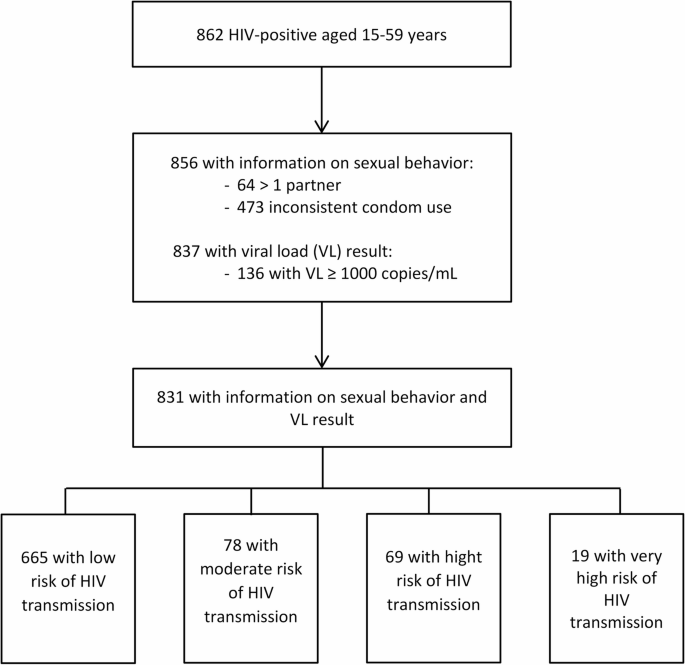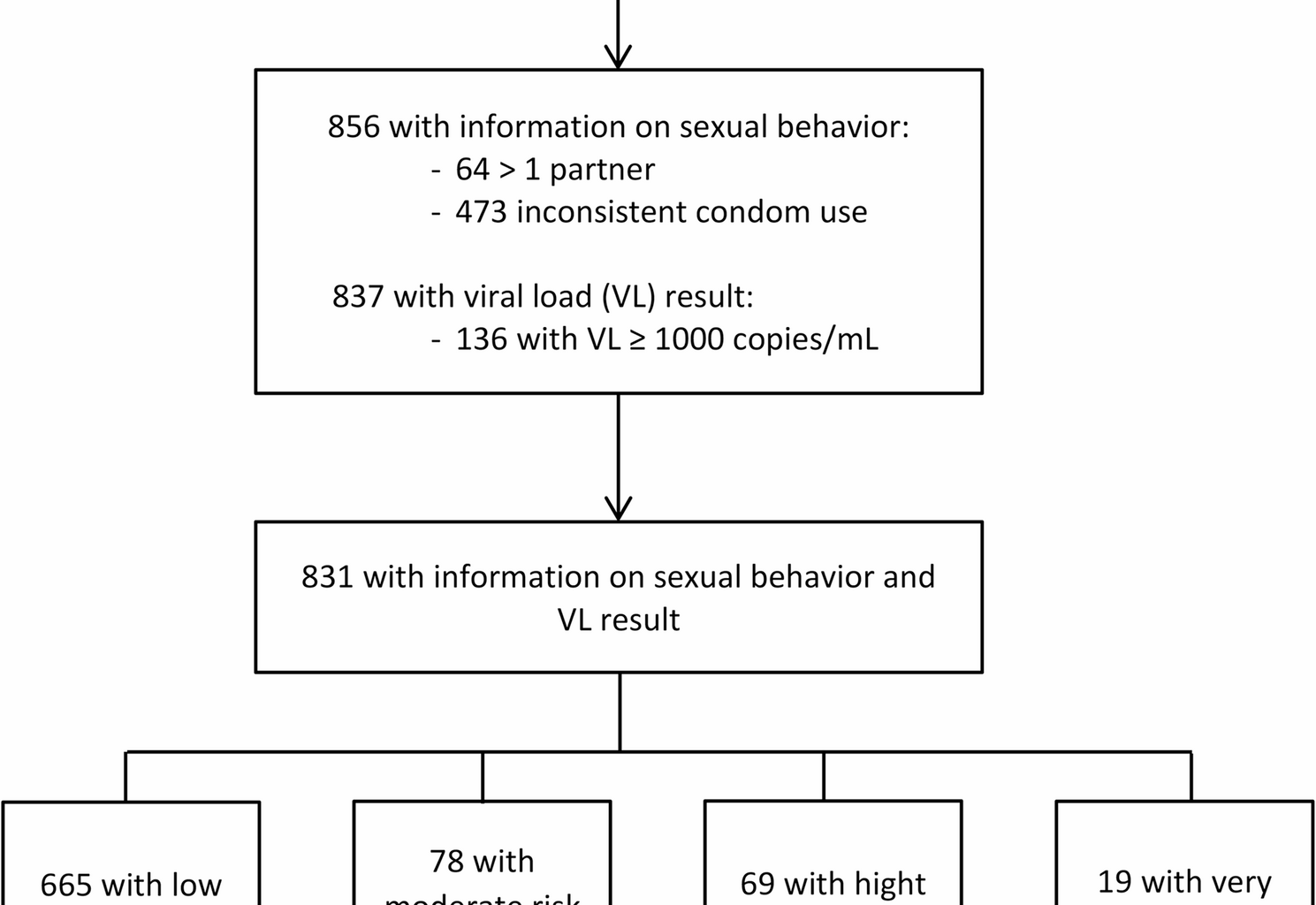In total, 3,286 individuals 15-59 years were included in the survey. The inclusion rate among this age group was 80.0% (3,286/4,109), with a higher rate among women (84.7%, 2,165/2,557) compared to men (72.2%, 1,121/1,552), p
In total, 862 individuals HIV-positive aged 15-59 years were included in this analysis. Of them, 657 (76.2%) were women and the median age was 36 years [interquartile range, IQR: 29-46]. Overall, 68.7% (592/861) of these individuals had never been married and 91.2% (786/862) had completed at least primary school. Demographic data are presented in Table 1.
Table 1 Socio-demographic characteristics of the 862 HIV-positive participantsSexual partners and condom use
Among the 856 HIV-positive participants who reported the number of partners they had in the past, 671 (78.4%, (95%CI 75.5–81.0)) reported at least one sexual partner in the preceding year (Table 2). More men than women reported having more than one partner in the previous year: 20.2% of men versus 3.5% of the women (p p
Table 2 Number of sexual partners in the previous 12 months by sex and age group
Among the 677 HIV-positive individuals who reported having sexual intercourse in the preceding year (including 6 who did not report the number of partners), 33 (4.9%) engaged in a casual or transactional relationship. This proportion was higher among men than women, 12.6% (22/175) versus 2.2% (11/502) respectively (p
Among participants who had sexual intercourse in the preceding year, 46.9% (95%CI 43.2-50.7) (315/671) consistently used condoms: 47.1% among women versus 46.3% among men; p=0.83. Consistent condom use was lower in individuals aged 20-34 years compared to those aged 15-19 and 35-59 (42.9% (139/324), 57.9% (11/19) and 43.1% (212/492) respectively, p-value=0.43), and in those reporting more than one partner compared to those with one partner (23.4%, (95%CI 14.5-35.6) (15/64) versus 49.4%, 45.4-53.4 (300/607), p
HIV-positive awareness, ART intake and viral suppression
In total, 10.1% (95%CI 8.2-12.3) (87/862) of the HIV-positive participants were unaware of their HIV status, 15.8% (95%CI 13.4-18.2) (135/862) were not on ART and 16.3% (95%CI 13.9-18.9) (136/837) had a VL≥1000 copies/mL. Both men and youths aged 15 to19, regardless of gender, were more likely to be unaware and virally unsuppressed (Table 3). Among those aware, 6.2% (95%CI 4.7-8.1) (48/775) were not on ART. Among those aware and treated, there were no differences between women and men with regards to viral suppression (5.0% (28/564) versus 7.7% (11/143) were unsuppressed respectively, p=0.20); however, youths aged 15-19 on ART were more likely to be virally unsuppressed than older counterparts (23.3% (95%CI 11.1-42.4) (7/30) versus 8.2% (95%CI 5.3-12.4) (20/244) among the 20-34 and 2.8% (95%CI 1.6-4.8) (12/433) among the 35-59, P
Table 3 Viral suppression and awareness of HIV status among participants reporting sexual activity, by gender and age groupGroups at risk of maintaining HIV transmission
Participants with more than one partner and inconsistent condom use had the highest proportion of unawareness compared to other groups (Table 4). Among HIV-positive men, 43.3% (13/30) with more than one partner and inconsistent condom use, 54.6% (6/11) with more than one partner and consistent condom use and 28.3% (17/60) with one partner with inconsistent condom use, were virally unsuppressed. In women, these proportions were 31.6% (6/19), 25.0% (1/4), and 19.1% (45/236) respectively.
Table 4 Sexual behavior, HIV-positive awareness and viral suppression among HIV-positive participants by gender (N = 856)
The proportion of virally unsuppressed participants on ART was higher among those with more than one partner and consistent or inconsistent condom use compared to the other groups. It was similar among men and women with consistent condom use (28.6% (2/7) versus 25.0% (1/4) respectively; p=0.898,), and with inconsistent condom use (11.8% (2/17) versus 13.3% (2/15), p=0.893). In all sexual behavior groups, individuals aged 15-19 years were more virally unsuppressed than other age groups. The distribution of sexual behavior, unawareness and being unsuppressed among HIV-positive by age group is presented in the Supplement file (Table S1).
Among HIV-positive participants with a viral load result and information of sexual behavior, 88/831 (10.6%, (95%CI 8.7-12.9)) had a high or very high risk of sexually transmitting HIV (Figure 1). Of these, 40.9% (95%CI 31.0-51.6) were men, 58.0% (95%CI 47.3-67.9) were aged 20-34 years, 42.0% (95%C 32.1-52.7) were women aged 20 to 34 years, and 39.8% (95%CI 30.0-50.4) were men aged 20 to 59 years (Table 5). In the low or moderate risk groups, 21.7% (95%CI 18.8-24.8) were men, 34.9%(95%CI 31.5-38.4) were aged 20-34 years, 29.2% (95%CI 26.0-32.6) were women aged 20 to 34 years, and 20.2% (95%CI 17.5-23.2) men aged 20-59 years.
Table 5 Characteristic of HIV-positive according to their risk of HIV transmission (N = 831)Fig. 1
Levels of HIV transmission risk among participants
Among HIV-positive participants with a viral load result and information of sexual behavior, 88/831 (10.6%, (95%CI 8.7-12.9)) had a high or very high risk of sexually transmitting HIV (Figure 1). Of these, 40.9% (95%CI 31.0-51.6) were men, 58.0% (95%CI 47.3-67.9) were aged 20-34 years, 42.0% (95%C 32.1-52.7) were women aged 20 to 34 years, and 39.8% (95%CI 30.0-50.4) were men aged 20 to 59 years (Table 5). In the low or moderate risk groups, 21.7% (95%CI 18.8-24.8) were men, 34.9%(95%CI 31.5-38.4) were aged 20-34 years, 29.2% (95%CI 26.0-32.6) were women aged 20 to 34 years, and 20.2% (95%CI 17.5-23.2) men aged 20-59 years.
Participants at high or very high-risk of transmitting HIV were more frequently unaware of their HIV status and untreated compared to those with lower risk: 50.0% versus 4.8% unaware (p
Of the 19 participants at very high risk of HIV transmission (2.3% of the HIV-positive with viral load result), 68.4% (95%CI 43.4-85.9) were men aged 20-59 years, 52.6% (95%CI 29.7-74.5) were unaware of their status, 78.9% (95%CI 53.5-92.4) were not on ART, 26.3% were aware but not on ART, and 21.1% were aware and on ART. The majority (89.5%,(95%CI 63.9-97.6)) had at least one previous HIV test and 26.3% (95%CI 10.7-51.6) had a casual or transactional partner in the preceding year.
